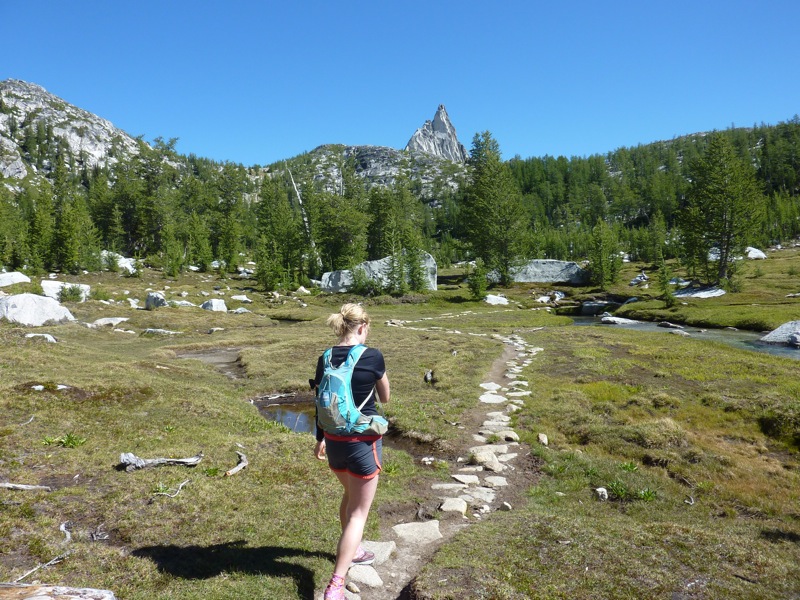I don't know who first offered this piece of wisdom, but it is something to keep in mind at your next competition:
"You don't win races with your feet, you win them with your mind."
I had heard this seemly trite quote before, but it wasn't until yesterday that the message helped me fend off a runner and earn a second-place finish at the Woolley Trail 50k.
At the mind-numbingly early hour of 5am, my girlfriend Sophia, friend Heather and I loaded our water bottles, spare clothes and trail shoes into Sophia's Honda Civic and drove north on I-5. The morning was frosty, with the thermometer hanging in the low 30s, but felt much colder. It would be a few hours before the sun would make an appearance.
At exit 232, we turned off the freeway and headed east on highway 20. Within a few miles we arrived in the sleepy town of Seedro-Woolley, temporarily inundated with 150 ultra runners for the Woolley Trails 50k, marathon and 1/2 marathon trail runs.
The course was an out-and-back route on a 15 mile section of the Cascade Trail. Flat as a pancake, the only obstacles on the crushed gravel trail were a few downed trees and a 200' stretch of the course intersected by a shallow stream pumping ice cold water.
Technically, this was just a fun run, not sanctioned by any racing groups, but when I lined up at the start at five minutes to 7, I felt a surprising hunger to compete. I had never finished a race in the top five before, and barely broke the top ten in previous competitions. However, today, the idea of pushing myself wandered into my mind. "Maybe" I told myself.
Following a briefing by race director Terry Sentinella, runners took off into a dimly lit and frigid morning.
The first 15 miles of the race were as I expected (with the exception of the buffalo and alpaca grazing next to the trail). A group of us, mostly men with the exception of the powerful Shawn McTaggart, pushed to the front and set a 7:15/mile pace. This was a little fast for me, so I dropped back and settled at a 7:30/mile, running alone in the cold.
Because runners were competing in 1/2 marathon, marathon and 50K distances on the same course, I wasn't totally sure of who was ahead of me until I approached the turn-around for the 50K distance. The 50k leader was a 100%-business looking runner in his late-30s who was dialed in and at least a mile ahead of me. I looked around but didn't see anyone else between me and the turn-around.
Wait! Could I be in second?
After grabbing half of a PB&J sandwich and refilling my water bottle at the aid station, I thanked the cheerful volunteers and started my return run. While catching the front runner was out of the question, if I could hold out, I could finish stronger than I've ever done before.
As the miles began to tick by...20, ...22, ..24, my demeanor changed from competitive fun-run to 100%-business, too. The morning felt bright and I just kicked one foot in front of the other.
Despite my determination, at some point in the last quarter of the 50k I gradually started to slow down. With no one around me, my pace slowed.
I didn't realize that I was being stalked.
At mile 28, the sound of foot steps came out of nowhere. I checked over my left shoulder and saw another runner, a male in his 40s with a high tempo gaining on me with what seemed like an effortless advance. Suddenly, he pulls parallel to me.
Shoot! I've got just three miles left, and he has more gas in his tank than I do! Wait, could he be running the marathon distance instead of the 50K?
"You're running the 50K, right" I asked.
"Yeah" he replied in a friendly, but focused tone.
"Same here" I replied, knowing that a duel was about to happen.
Grinning, he replied "I guessed that".
A moment after this exchange he begins to lead me by 10 feet. While he was the stalker for 27 miles, now he was the underdog hero coming to take what was his. I have to hold on!
Panicked, I thought back to a book I'm reading, Open, the autobiography by tennis great Andre Agassi. He describes tennis matches against pros who at the time were much better than him. Agassi described using mental games to take the wind out of competitors by making them think that he was stronger, even when he wasn't.
That's what I have to do.
With just three miles left, I had to make my move and I'd have to do it in a way that would make the other runner think I was stronger than I was--to take away his hope.
The mind game was on!
In a dramatic flair, I threw my hand-held Nathan water bottles to the ground, lightening my load, and began to swing my arms with full vigor. I quieted my breath to make it sound like I wasn't working as hard as I was. When the moment just right, and with only two miles to the finish, I pushed past him in one smooth acceleration, never looking back or checking my watch. My stare was fixed on the last two miles of the 50k.
After stepping through the stream that bisected the trail, I crossed the finish with a surprisingly quick time of 4:12:36, capturing 2nd, my best finish ever.
What mind games have you used to compete?




















